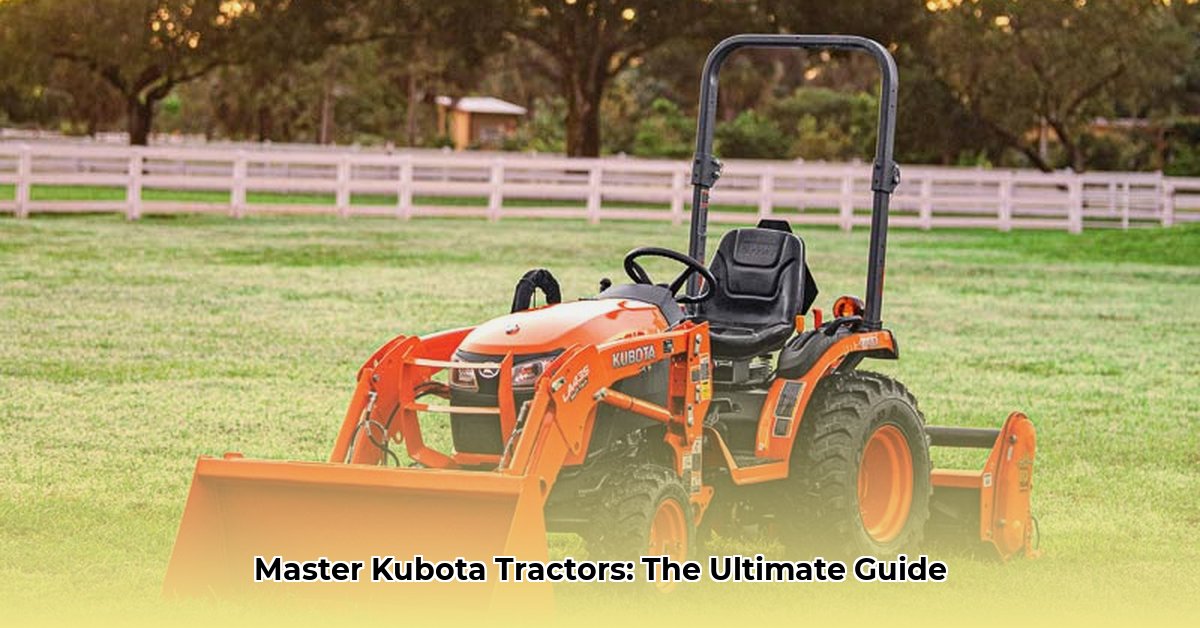
This comprehensive guide provides a step-by-step approach to operating a Kubota tractor. Remember, always consult your specific Kubota model's operator's manual for detailed instructions and safety information. This guide serves as a helpful overview, not a replacement for the official documentation. Safe and responsible operation is paramount. For more information on front loaders, see this helpful guide on Kubota Front Loaders.
Pre-Operation Checklist: Ensuring a Safe Start
Before starting your Kubota, a thorough pre-operation check is crucial. This preventative step minimizes risks and maximizes efficiency.
Fuel Level Check: Verify sufficient fuel. Low fuel mid-operation can lead to costly downtime. Is your fuel gauge reading comfortably above the minimum?
Fluid Levels: Inspect engine oil, transmission fluid, hydraulic fluid, and coolant. Low fluid levels can severely damage your engine and other components. Are all fluids at the correct levels, according to your owner's manual?
Tire Pressure: Check and adjust tire pressure according to your owner's manual. Incorrect inflation can impact traction and lead to tire damage. Do your tires meet the recommended pressure specifications?
Visual Inspection: Conduct a walk-around inspection, carefully examining for loose parts, leaks, or any damage. Addressing minor issues early prevents major problems down the line. Are there any visible signs of damage or leaks?
Starting and Stopping the Tractor: A Smooth Process
Starting and stopping your Kubota requires a methodical approach to ensure safety and longevity.
Engage the Parking Brake: Firmly engage the parking brake before starting the engine. This prevents accidental movement.
PTO Disengagement: Ensure the power take-off (PTO) is disengaged. A running PTO with the engine starting can lead to serious injury.
Engine Start: Start the engine according to your operator's manual. Allow the engine to reach its normal operating speed before engaging any implements.
Engine Shutdown: Slowly reduce speed, disengage the PTO, engage the parking brake, and then turn off the engine.
Operating the Transmission & Controls: Gaining Confidence
Understanding your Kubota's transmission and controls is essential for efficient and safe operation. Your owner's manual provides detailed information specific to your model.
Gear Shifting: Practice smooth gear changes to avoid sudden jolts and transmission damage. The clutch is vital for smooth transitions.
Braking System: Familiarize yourself with the service and parking brakes. Know how to utilize both effectively for safe stopping and secure parking.
Steering: Acclimate yourself to the steering feel, taking into account power steering capabilities. Practice maneuvering in open areas before working in tighter spaces.
Speed Control: Adjust speed according to the task and terrain conditions. Maintaining a slow and controlled speed is critical, especially when operating implements or on uneven surfaces.
Using the Three-Point Hitch: Attaching and Operating Implements
The three-point hitch system is integral to using implements with your Kubota.
Implement Attachment: Carefully attach implements according to the instructions in your owner's manual. Ensure proper alignment and secure fastening to prevent accidents and ensure efficient operation.
Hitch Adjustment: Adjust the hitch settings as needed for different implements and tasks. Your manual provides detailed instructions for specific settings.
Safe Operation: Maintain awareness of the implement's position and surroundings, especially when operating near obstacles or other individuals.
Operating the PTO (Power Take-Off): Powering Implements Safely
The PTO transmits power to implements. Safe PTO operation is critical.
PTO Engagement: Only engage the PTO when necessary and after verifying the implement is ready. Ensure the tractor is at the correct speed before engaging.
PTO Disengagement: Always disengage the PTO before stopping the tractor. This prevents accidental engagement or damage.
Safety Precautions: Never reach into moving parts or near a running PTO. This is an extreme safety hazard.
Using a Front Loader (If Applicable): Safe Loading and Unloading
If your Kubota has a front loader, proper operation is essential for safety and efficiency.
Loading: Scoop material smoothly and maintain balance to prevent tipping.
Unloading: Carefully release the load for a controlled drop.
Maneuvering: Drive cautiously with a full load, adjusting speed according to load and conditions.
Maintenance and Troubleshooting: Proactive Care
Regular maintenance is vital for your Kubota's longevity and performance.
Fluid Changes: Consult your owner's manual for recommended service intervals and fluid types. Consistent fluid changes are critical for optimal performance.
Tire Pressure Monitoring: Regularly check and adjust tire pressure. Proper inflation is essential for traction and minimizing wear.
Visual Inspections: Regularly inspect for signs of wear, damage, or leaks. Early detection prevents costly repairs.
Safety Procedures: Prioritizing Safety
Safety is paramount during all Kubota operations.
Emergency Shut-Off: Familiarize yourself with the location and operation of the emergency shut-off.
Terrain Awareness: Adjust your driving style to the terrain. Steep inclines require more caution than level ground.
Hazard Awareness: Always remain aware of obstacles, uneven terrain, and power lines.
Conclusion: Responsible Kubota Operation
This guide provides a foundational understanding of Kubota tractor operation. Always refer to your owner's manual for specific details pertinent to your tractor model. Safe and responsible operation ensures both your safety and the longevity of your equipment. Remember, ongoing learning and adherence to your manual's safety guidelines are critical for successful and safe Kubota operation.